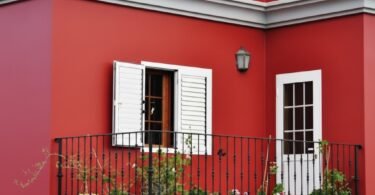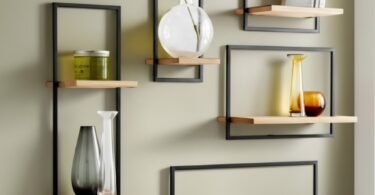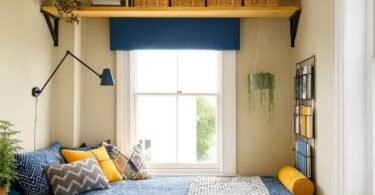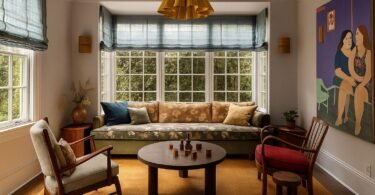Let me tell you something I’ve learned after watching countless friends stress over their home values. Apart from our families, our home is our most prized possession. We spend countless hours picking out the perfect throw pillows, arguing with our spouses about paint colors, and trying to make every corner feel like it belongs in a magazine. I’ve been there, standing in Home Depot at 7 PM on a Sunday, wondering if sage green or forest green would make my living room feel more “me.”
The thing is, our homes don’t stay frozen in time like we sometimes wish they would. What felt cutting-edge five years ago now looks dated. That kitchen backsplash you loved in 2019? Your neighbor’s teenager probably thinks it’s “so millennial.” We all face this reality eventually. Time marches forward, trends shift, and our once-modern spaces start showing their age.
But here’s what I’ve discovered through years of home ownership and watching my friends navigate renovations. The key isn’t chasing every trend that pops up on Pinterest. Smart homeowners focus on updates that serve two masters at once. They make your daily life better while protecting your investment. These changes let you enjoy your space more today while setting you up for a better return tomorrow.
I’ve watched neighbors throw money at flashy upgrades that looked impressive but didn’t move the needle on their home’s worth. Then I’ve seen others make strategic choices that transformed both their lifestyle and their property value. The difference usually comes down to understanding what buyers actually want versus what looks good in photos.
Your home should feel like your sanctuary. That cozy corner where you drink your morning coffee, the kitchen island where your kids do homework while you cook dinner, the backyard spot where you unwind after tough days. These spaces matter deeply to how we live. When we improve them thoughtfully, we’re not just spending money. We’re investing in better daily experiences and stronger financial futures.
The five strategies I’m sharing aren’t random ideas I pulled from design blogs. They come from real conversations with real estate agents, contractors who’ve seen what works, and homeowners who’ve been through successful renovations. Some of these tips might surprise you with their simplicity. Others might challenge assumptions you’ve held about home improvement.
What I can promise is this. Each approach has proven itself in actual markets with actual buyers. They’ve helped friends increase their home values while creating spaces they genuinely love living in. Because at the end of the day, the best home improvement is one that makes you smile every time you walk through your front door.
Make Renovating Your Kitchen a First Port of Call
Walk into any house party, and I guarantee you’ll find everyone gathered in the kitchen. Doesn’t matter if the host spent thousands on a gorgeous living room setup. People gravitate toward where the food is, where the coffee brews, and where the real conversations happen. That’s why smart renovators always start here. The kitchen isn’t just where we cook anymore. It’s command central for modern family life.
I learned this lesson the hard way when we bought our first house. The kitchen was stuck in 1987, complete with oak cabinets and laminate countertops that had seen better decades. We kept telling ourselves we’d “make it work” and focus on other rooms first. Big mistake. Every day felt like a compromise. Making breakfast meant working around cramped counter space. Cooking dinner became a frustrating dance around inefficient layouts. Friends would visit and immediately suggest we “do something” about the kitchen situation.
Here’s what most people don’t realize about kitchen renovations. You don’t need to gut everything to create dramatic change. Strategic upgrades can transform the space without requiring a second mortgage. Start with appliances, the workhorses that get used multiple times daily. Stainless steel remains the gold standard because it photographs well, cleans easily, and appeals to the widest range of tastes.
Energy efficiency matters more than most homeowners think. Those old appliances aren’t just ugly. They’re probably costing you money every month through higher utility bills. Modern refrigerators use a fraction of the energy compared to models from even ten years ago. New dishwashers clean better while using less water. Induction cooktops heat faster and give you more precise control. These aren’t just nice features. They’re selling points that resonate with environmentally conscious buyers.
Countertops tell the story of your kitchen’s quality level. Laminate screams “budget renovation” while natural stone whispers “thoughtful investment.” Granite has proven its staying power in the market. It handles daily abuse, comes in countless patterns, and still feels luxurious years after installation. Quartz offers even better durability with less maintenance. These surfaces cost more upfront but they pay dividends in daily satisfaction and resale value.
Flooring might be the most underestimated element in kitchen design. Carpet in kitchens disappeared for good reason. It absorbs spills, harbors odors, and looks dated quickly. Tile offers endless design possibilities with practical benefits. It cleans easily, handles moisture well, and can look expensive without breaking budgets. Hardwood brings warmth but requires more care around sinks and dishwashers. Luxury vinyl has come so far that many people can’t tell the difference from real wood or stone.
Cabinet upgrades offer the biggest visual impact for your renovation dollar. Full replacement gives you exactly what you want but costs significantly more. Refacing existing cabinets can cut costs by 50% while delivering similar results. New doors, drawer fronts, and hardware can completely change your kitchen’s personality. Choose classic styles over trendy ones for better long-term appeal. Shaker doors remain popular because they work with both traditional and contemporary design schemes.
Don’t underestimate the power of proper hardware. Cabinet pulls and knobs are like jewelry for your kitchen. They’re relatively inexpensive but make everything look more finished and intentional. Brushed nickel and black finishes have staying power. Brass is making a comeback but might feel dated again in five years. Stick with classic choices unless you plan to update regularly.
Lighting can make or break your kitchen’s functionality and atmosphere. Under-cabinet LEDs eliminate shadows on work surfaces while creating ambiance for evening entertaining. Pendant lights over islands provide task lighting and visual interest. Recessed ceiling fixtures offer general illumination without cluttering sight lines. Layer different light sources for maximum flexibility and appeal.
Paint Breathes New Life into a Tired Home
There’s something almost magical about watching a room transform under fresh paint. I’ve seen spaces go from depressing to inspiring in a single weekend. Paint might be the most democratic home improvement tool we have. You don’t need special skills, expensive tools, or contractor connections. Just some time, patience, and willingness to get a little messy.
The psychological impact of color shouldn’t be underestimated. We respond to colors in ways we don’t always consciously recognize. That dingy beige that seemed “safe” when you moved in? It might be making your mornings feel more mundane than they need to be. Rich, warm colors can make large spaces feel cozy. Light, cool colors can make small spaces feel larger. The right paint choice can literally change how you feel in your own home.
I remember helping my sister paint her living room last spring. She’d been complaining about feeling depressed every time she sat in that space. The walls were this sad, grayish color that sucked energy from everything around it. We spent a Saturday rolling on warm, creamy white with subtle gray undertones. By Sunday evening, she was texting me photos of herself reading on the couch, captioning them “I actually want to spend time in here now.” That’s the power of good paint choices.
Accent walls have become incredibly popular, and for good reason. They let you experiment with bold colors without overwhelming your space or your budget. Pick the wall that naturally draws attention when you enter the room. Maybe it’s behind your bed, opposite your front door, or where your TV hangs. Paint it in a color that complements but contrasts with your main wall color. Deep blues, rich greens, or warm terracottas can create stunning focal points without feeling too dramatic.
Choosing colors can feel overwhelming with thousands of options available. Here’s a trick I’ve learned from watching successful renovators. Start with your existing furniture, artwork, and textiles. Pull colors that already exist in your space rather than starting from scratch. That throw pillow you love might contain the perfect wall color. Your favorite piece of art might suggest a whole color palette. Building from what you already own creates cohesion and saves money.
Neutral doesn’t have to mean boring. The most sophisticated spaces often use subtle variations of neutrals to create depth and interest. Warm whites feel inviting and timeless. Soft grays work with almost any decorating style. Gentle beiges create cozy backgrounds for colorful accessories. These colors photograph beautifully for future resale and won’t feel dated in five years.
Quality paint makes a bigger difference than most people realize. Cheap paint requires more coats, covers less evenly, and fades faster. Premium paints go on smoother, hide imperfections better, and maintain their color longer. They often contain better ingredients that resist stains and clean more easily. When you calculate the cost of your time, good paint becomes even more economical.
Preparation makes the difference between amateur and professional results. Most people want to skip straight to the fun rolling part, but walls need attention first. Fill nail holes, sand rough spots, and clean surfaces thoroughly. Prime over dark colors or stains. Remove outlet covers and light switch plates. Tape edges carefully using quality painter’s tape. These steps take time but they’re what separate okay results from great ones.
Don’t underestimate the importance of proper tools. Good brushes and rollers create smoother finishes with less effort. Extension poles save your back and create more even coverage on walls and ceilings. Quality drop cloths protect your floors and furniture better than old sheets or plastic. Invest in tools you can use for future projects rather than buying the cheapest options.
Timing your paint project can make the work more pleasant and successful. Avoid painting during humid weather when paint takes longer to dry. Open windows for ventilation but avoid windy days that blow dust into wet paint. Start early in the day to maximize drying time before evening. Plan for two days minimum so you’re not rushed and can apply second coats properly.
New Flooring is a Huge Value Add
Floors might be the hardest working surfaces in our homes, yet we often take them for granted until they start looking tired. Every step, every dropped toy, every furniture rearrangement leaves its mark. When floors look worn, the entire house feels dated regardless of what else you’ve updated. Conversely, beautiful floors can make even budget furniture look more expensive.
The carpet conversation has shifted dramatically over the past decade. What once seemed like the obvious choice for bedrooms and living areas now feels outdated to many buyers. I’ve watched friends struggle to sell homes with wall-to-wall carpet throughout. Potential buyers walk in and immediately start calculating replacement costs in their heads. Meanwhile, homes with hardwood or luxury vinyl get offers faster and often above asking price.
Hardwood flooring remains the gold standard for good reason. It’s beautiful, durable, and actually improves with age when properly maintained. Solid hardwood can be refinished multiple times over decades of use. Engineered hardwood offers similar looks with better moisture resistance and easier installation. Both options increase home values significantly and appeal to the widest range of buyers.
The variety in hardwood options can feel overwhelming. Oak remains classic and widely available. Maple offers subtle grain patterns and light colors. Cherry develops rich patinas over time. Walnut brings dramatic dark tones to contemporary spaces. Exotic species like Brazilian cherry or teak create unique looks but cost significantly more. Consider your climate, lifestyle, and budget when making selections.
Bamboo flooring deserves serious consideration as an eco-friendly alternative to traditional hardwood. It grows much faster than trees, making it more sustainable. Modern bamboo floors look beautiful and perform well under normal household conditions. They cost less than most hardwood options while offering similar aesthetic appeal. Some varieties can be refinished like traditional wood floors.
Tile flooring has evolved far beyond basic ceramic squares. Large format tiles create seamless looks with fewer grout lines to maintain. Wood-look tiles offer hardwood aesthetics with superior moisture resistance. Natural stone tiles bring unique patterns and textures impossible to replicate artificially. Luxury vinyl tiles now mimic expensive materials so convincingly that many people can’t tell the difference.
The practical benefits of hard flooring extend beyond aesthetics. Families with allergies find relief from eliminating carpet that traps dust, pet dander, and other irritants. Homes with pets benefit from surfaces that clean easily and don’t absorb odors. Parents with small children appreciate floors that handle spills without permanent damage. These daily quality of life improvements matter as much as resale value.
Installation costs vary dramatically based on material choices and room layouts. Simple rectangular rooms with few obstacles cost less to floor than spaces with lots of angles, built-ins, or transitions between different materials. Some flooring types require extensive subfloor preparation that can double project costs. Get detailed estimates that include all necessary prep work, materials, and labor.
Maintenance requirements differ significantly between flooring types. Hardwood needs periodic refinishing but can last generations with proper care. Tile is virtually maintenance-free but grout may need attention over time. Luxury vinyl requires only regular cleaning but can’t be repaired if damaged. Consider your lifestyle and maintenance preferences when choosing materials.
Don’t overlook the importance of quality underlayment and installation. The best flooring materials can fail with poor installation. Uneven subfloors cause premature wear and creaking sounds. Inadequate moisture barriers lead to warping and mold issues. Hire experienced installers who stand behind their work with solid warranties. Cut-rate installation often costs more in the long run through repairs and replacements.

Curb Appeal Because First Impressions Count
Your home’s exterior tells a story before visitors even ring the doorbell. That story might be “welcome to a place where attention to detail matters” or “the owners have given up on maintenance.” I’ve seen beautiful interiors get overlooked because buyers couldn’t get past shabby exteriors. The reverse is also true. Stunning curb appeal can make people fall in love before they see a single room inside.
Real estate agents know that most buyers make emotional decisions within the first few seconds of seeing a property. They’re not consciously evaluating landscaping or analyzing paint conditions. They’re feeling something. Either “I could live here happily” or “this isn’t for us.” Your exterior creates that crucial first impression that colors everything else buyers experience during showings.
Landscaping doesn’t have to be expensive to be effective. Healthy, well-maintained grass signals that owners care about their property. Patchy, weedy lawns suggest deferred maintenance throughout the house. If your grass struggles due to shade, consider alternatives like groundcover or mulched beds with shade-loving plants. The goal is creating neat, intentional appearances rather than perfect suburban lawns.
Trees and shrubs provide structure and seasonal interest to your landscape. Mature specimens add significant value because they take years to establish. Overgrown plantings create the opposite effect by making properties look neglected. Regular pruning keeps plants healthy while maintaining clean sight lines to your house. Remove dead or diseased plants immediately as they detract from overall impressions.
The pathway to your front door should feel inviting and clearly defined. Cracked concrete or loose pavers create tripping hazards and negative impressions. Simple materials like brick, flagstone, or decorative concrete can transform boring walkways into attractive features. Adequate lighting along paths increases safety while extending the hours your home looks welcoming.
Front door treatments offer high-impact opportunities for relatively small investments. Fresh paint in classic colors like deep blue, forest green, or rich red creates focal points that draw visitors forward. Replacing dated hardware with quality locksets and handles improves both function and appearance. Seasonal wreaths or planters add welcoming touches that show someone cares about details.
Flower beds provide opportunities to add color and personality to your landscape. Annual flowers offer bright seasonal displays but require replanting yearly. Perennials cost more initially but return year after year with proper care. Mixing both types creates constant interest throughout growing seasons. Choose plants suited to your climate and maintenance preferences rather than copying magazine photos.
Window boxes and containers let you add color even without garden space. They’re perfect for renters who can’t make permanent landscape changes. Quality planters cost more than plastic ones but look better and last longer. Group containers in odd numbers for more natural appearances. Keep plantings proportional to container sizes and architectural details.
Power washing can dramatically improve your home’s appearance with minimal cost and effort. Years of dirt, pollen, and mildew accumulate on siding, walks, and driveways. Professional cleaning reveals original colors and textures while removing stains you might not have noticed developing gradually. Most homeowners can rent equipment and handle the work themselves over a weekend.
Exterior lighting extends your home’s curb appeal into evening hours. Well-placed fixtures highlight architectural features and landscape elements while improving security. Solar options have improved dramatically and require no electrical work. Low-voltage systems offer more control and brighter illumination with professional installation. Avoid overdoing lighting as subtle enhancement works better than theatrical displays.
Mailboxes and house numbers might seem like minor details but they contribute to overall impressions. Rusty mailboxes with peeling numbers suggest owners don’t pay attention to maintenance. Quality replacements cost relatively little but send positive messages about property care. Ensure house numbers are clearly visible from the street for emergency services and delivery drivers.
Build a Backyard Retreat to Get Away From It All
The pandemic changed how we think about our outdoor spaces. Suddenly, backyards weren’t just places to store lawn mowers and forgotten patio furniture. They became extensions of our living space, outdoor offices, and vacation destinations we couldn’t travel to. I watched friends transform neglected yards into spaces they genuinely preferred over their indoor rooms. The trend shows no signs of slowing down.
Creating outdoor living spaces starts with understanding how you actually want to use the area. Do you dream of morning coffee surrounded by birds and flowers? Evening gatherings around fire pits with friends? Quiet reading spots shaded from afternoon sun? Family barbecues that flow seamlessly between kitchen and patio? Your lifestyle should drive design decisions rather than copying ideas that look good but don’t fit your reality.
Outdoor kitchens represent the ultimate in backyard luxury, but they don’t have to cost a fortune to be functional. Start with a quality grill as your foundation. Add a prep station with storage for utensils and supplies. Include a small refrigerator for cold drinks and condiments. Consider a sink for easy cleanup. These elements can be built gradually over time as budget allows, creating a space that rivals expensive restaurants for outdoor dining experiences.
Water features add sensory richness that transforms ordinary backyards into tranquil retreats. The sound of moving water masks neighborhood noise while creating peaceful atmospheres. Simple fountain kits cost less than weekend getaways but provide daily relaxation benefits. Larger installations like ponds or waterfalls require more planning and maintenance but create stunning focal points that increase property values significantly.
Fire features extend the usefulness of outdoor spaces into cooler months and evening hours. Fire pits encourage gathering and conversation in ways that televisions never can. Built-in fireplaces create elegant focal points for seating areas. Modern gas options offer convenience without the work of building wood fires. Safety considerations include proper clearances from structures and overhead branches.
Lighting transforms backyards from daytime-only spaces into enchanting evening retreats. String lights create magical atmospheres perfect for entertaining. Landscape lighting highlights architectural features and mature plants while providing security. Path lights guide movement safely through garden areas after dark. Solar options have improved dramatically while eliminating electrical work for many applications.
Covered areas protect outdoor furniture while creating comfortable spaces regardless of weather conditions. Pergolas provide partial shade and structure for climbing plants. Gazebos offer full protection from sun and rain. Retractable awnings adjust coverage based on conditions. Even simple umbrellas can define seating areas while protecting from harsh sun. Consider prevailing winds and sun patterns when positioning covered spaces.
Comfortable seating anchors successful outdoor rooms. Weather-resistant materials like teak, aluminum, and quality synthetics maintain appearances through seasons of use. Cushions and pillows add color and comfort but require storage during harsh weather. Built-in seating creates permanent solutions that can’t be rearranged or stolen. Mix different seating types to accommodate various activities and group sizes.
Privacy screening helps outdoor spaces feel more intimate and usable. Fencing provides permanent solutions but can feel restrictive if too high or solid. Living screens using fast-growing plants create natural barriers that improve over time. Decorative screens offer instant privacy with artistic elements. Consider sight lines from neighboring properties when planning intimate outdoor areas.
Storage solutions keep outdoor spaces organized and functional. Weather-resistant containers protect cushions, tools, and seasonal items. Built-in storage benches provide seating and organization in compact packages. Sheds handle larger items but should complement your home’s architectural style. Easy access encourages regular use of stored items while security features protect valuable equipment.
Professional landscaping can tie all elements together into cohesive designs that feel intentional rather than collected over time. Landscape designers understand plant growth patterns, seasonal changes, and maintenance requirements that affect long-term success. They can create master plans that accommodate phased installation as budgets allow. Quality installation pays dividends through reduced maintenance and longer-lasting results.
We’ve covered a lot of ground together, from kitchen countertops to backyard fire pits. Each of these strategies works because they address fundamental human needs. We need functional kitchens where families can gather comfortably. We need spaces that feel fresh and reflect our personalities. We need floors that handle daily life without looking tired. We need exteriors that welcome us home each day. And we need outdoor areas where we can escape and recharge.
The best home improvements serve dual purposes. They make your daily life better while protecting your investment. When you love cooking in your updated kitchen, you’re getting immediate returns on that renovation dollar. When potential buyers fall in love with the same space years later, you get financial returns too. This double benefit separates smart improvements from expensive decorating mistakes.
Your home is indeed your castle, as the original author said. But castles need maintenance, updates, and thoughtful improvements over time. The strategies we’ve discussed aren’t about following every trend or creating magazine-worthy spaces. They’re about making your home work better for how you actually live while ensuring it remains attractive to future buyers.
I encourage you to start with one area that bothers you most in your daily routine. Maybe it’s that dated kitchen that makes cooking feel like a chore. Perhaps it’s the tired paint that dampens your mood every morning. It could be worn flooring that embarrasses you when friends visit. Start there, do it right, and let that success motivate your next project.
Remember, home improvement isn’t a race. Take time to research options, get quality materials, and hire skilled professionals when projects exceed your abilities. The best renovations happen thoughtfully over time rather than rushed through single ambitious weekends. Your home should support and enhance your life, not stress you out with constant projects.
Most importantly, choose improvements that genuinely appeal to you. Trends come and go, but good design principles and quality materials never go out of style. Trust your instincts, invest in lasting value, and create spaces that make you smile every time you walk through your front door. That’s the real measure of successful home improvement.







Leave a Comment